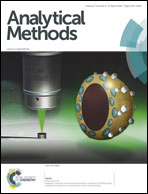FTIR spectroscopic metabolome analysis of lyophilized and fresh Saccharomyces cerevisiae yeast cells†
Abstract
The yeast Saccharomyces cerevisiae is widely used as a biological eukaryotic model and also serves as a production organism in biotechnology. One of the methods used to avoid degradation of the yeast cell content is lyophilization. The use of lyophilized yeast cells has several advantages over fresh ones: samples can be easily transported and/or stored and variations of their metabolomic profiles do not occur during transport or storage. Fourier transform infrared (FTIR) spectroscopy is one of the most emerging approaches in modern biology that permits operation on very small quantities of whole cells without the need for extractions or purifications. This technique is very sensitive and not only allows the discrimination between different cell genotypes but also between different growth conditions. FTIR spectra provide interesting data on the metabolic status of the whole cell. Modern multivariate data processing was applied to analyse live fresh or lyophilized S. cerevisiae cells from different growth media. This study clearly demonstrates that yeast cells coming from an identical biological medium can be used indiscriminately for FTIR analysis whether they are analysed directly as live fresh cells or after lyophilization which is a freeze-drying process. Moreover, FTIR data obtained using lyophilized cells showed less variability.


 Please wait while we load your content...
Please wait while we load your content...